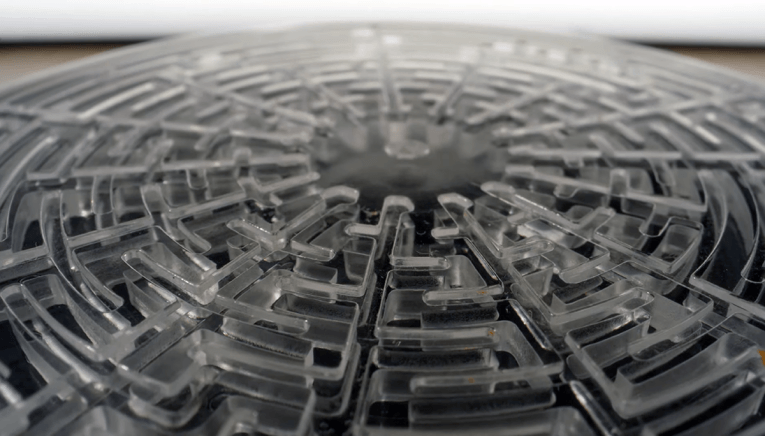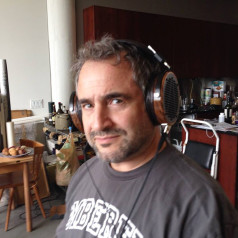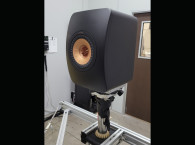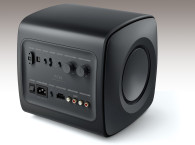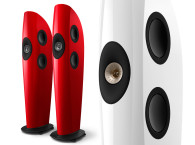
Writing up that show as my first article for audioXpress, I mentioned that “I got the briefest listen to some surprising speakers, like KEF’s LS50 (loved it a lot...).” Since that time, I’ve continued to hold the passive LS50 in high esteem as a performance benchmark in its price range. Fast forward to October of 2020, and a press release arriving in my email. The press release announced a new iteration of the LS50, this time with something novel to the industry; the inclusion of metamaterial. In brief, metamaterials are non-traditional physical materials and structures that are used to control the propagation of waves through and around them. Metamaterials counterintuitively manage to bend the rules of received wisdom, by cleverly manipulating energy in novel and surprising ways.
In the case of the LS50 Meta, the metamaterial takes the form of a quite small “unit-cell” structure repeated and nested in two dimensions to create a larger, disk-shaped region of material having highly optimized acoustical absorption properties. The disk, looking something like a diminutive labyrinth for insects, sits on an acoustically reflecting substrate. The structure, according to GP Acoustics* designers Sebastien Degraeve and Jack Oclee-Brown, is “...a continuum of acoustical resonators, tuned to have a constant number of resonances per octave above a cut-off frequency.”
The maze-like metamaterial is fabricated from injection-molded polymer. Since the metamaterial addition is the primary change in the new LS50, I will spend a fair amount of time discussing its construction and use in KEF’s latest iteration. I asked Oclee-Brown, KEF’s Head of Acoustics, what the magical new feature affords. By email, he told me that the LS50 Meta’s new Metamaterial Absorption Technology (MAT) is a metamaterial disk affixed to the rear of the Uni-Q driver. “This disk absorbs up to 99% of the back wave from 620Hz (on up). The result is detail and crispness at a completely new level of performance.”
The Audio Engineering Society (AES) Paper 10341, “Metamaterial Absorber for Loudspeaker Enclosures,” mentions that, “Since the resonators are very high Q, the absorption approaches 100% close to the resonance frequencies. However, the absorption drops to 50% to 80% at the anti-resonances because the spectral density is very low.”
An absorbing material (sponge) is added in front of the metamaterial to create an “absorption valley-filling” effect due to the surface impedance renormalization by the evanescent waves, and their interaction with a highly dissipative medium. The production version is the same as that described in the AES paper. The metamaterial is dual layer, two labyrinths of channels stacked one on the other, with a total of 30 channels. That disc–shaped metamaterial structure then has 1cm of open-cell foam, the “sponge,” applied to its face, and the entire assembly is attached to a conical duct. The metamaterial replaces a progressively damped, exponentially tapered horn, applied to the rear of the tweeter to load it and significantly and optimally reduce the energy being launched into the cabinet.
Oclee-Brown told me that the original LS50 used their patented vented tweeter design to control the back wave, but the MAT “...is an entirely new level of absorption for the unwanted back firing energy.”
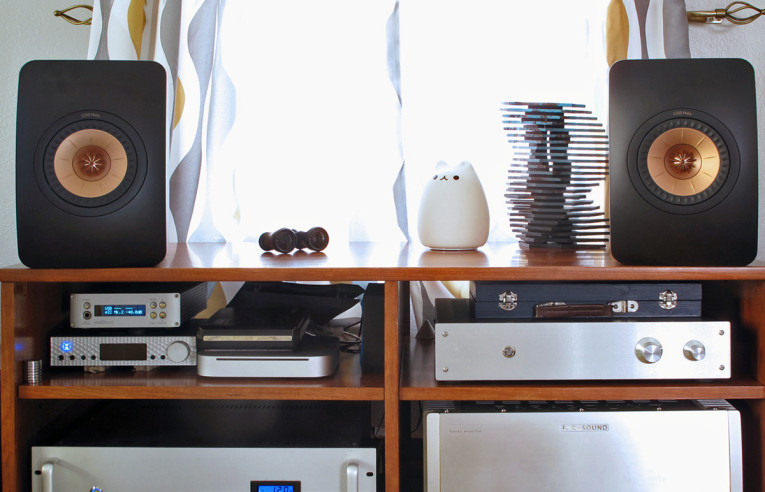
At Play
A quick speeds-and-feeds check yields the following: a Uni-Q concentric driver array featuring a 1” (25mm) vented aluminum dome tweeter with MAT, and a 5.25” (130mm) cone, also aluminum, for midrange and low-frequency duties. The crossover frequency is 2.1kHz and the sensitivity is spec’d as 85dB (2.83V/1m, A-weighted). Each 17.2lb. (7.8kg) speaker is nominally 8Ω though the minimum impedance is 3.68Ω at 217Hz, so thoughtful amplifier selection is indicated. The flared racetrack port is positioned on the back, and a nested, two-stage foam plug is included. A single set of five-way binding posts is supplied for hookup, and threaded inserts are positioned on the bottom for use with KEF’s $450 fillable S2 stand. The stand is available in the same matte finishes as the speaker; dark gray, black, white, and a very dark “royal blue.”

I started my subjective evaluation by pressing the exceptional Cambridge Acoustics’ Edge W into service. I had reviewed that 100W into 8Ω stereo amp in the January 2020 issue, and was fortunate enough to still have it in the house. The high quality, three-way binding posts on the rear of the LS50 Metas made it easy to wrangle my stiff Anticables Level 3.1 speaker wiring into place, plug in the bananas, and get everything hooked up. I left my home brewed swept tones and pink noise files to run overnight. What had started out as a bit gritty and congested rapidly cleaned up nicely to reveal what I would later come to realize is an unusually good sounding loudspeaker. For my first listen, I had stuffed the dual concentric open-cell foam plugs into the ports in the rear. That produced a tubby aspect to the upper bass that I was none too fond of, so I pulled those to let the speakers breathe. They stayed that way for the remainder of my listening.
Listening sessions began using the native Qobuz app. I then quickly switched to the same playlist and songs in Audirvana. The improvement in clarity and transient response with the combination of painstakingly crafted player app and innovatively engineered LS50 Meta was immediately evident. The same goes for Tidal. Switching from Audirvana to Tidal’s native app resulted in a shallower, shrunken soundstage and slightly darker top end, and that with an MQA half unfolding in Tidal’s app.
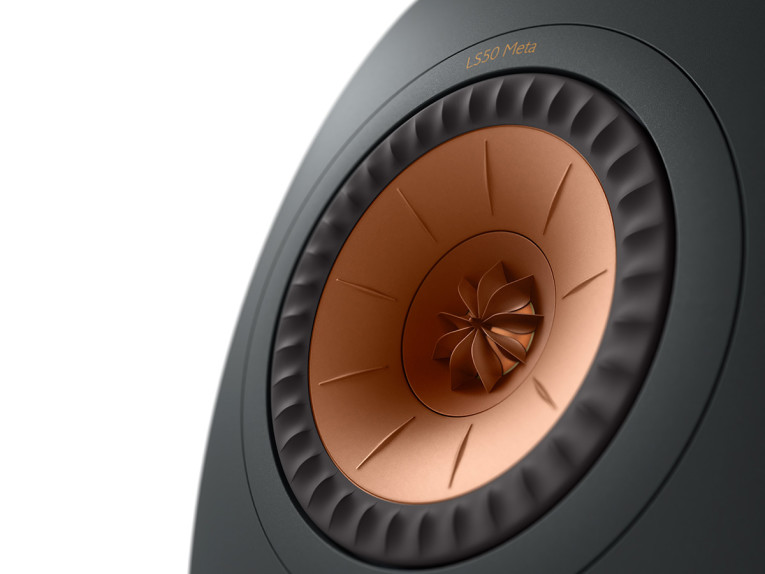
While listening to the title track from Bruce Springsteen’s latest, “Letter To You” [Qobuz 96k], I could clearly perceive a left-channel rhythm guitar strumming away just to the left of the left-hand loudspeaker. The LS50 Meta throws a wide, not tall soundstage, at least in my untreated room. I preferred the sound of the LS50 Meta directly on-axis vertically for the widest soundstage and flattest response.
Vertical dispersion is fairly narrow, Kent Peterson’s measurements (see the accompanying article) should provide more insight there. I do recommend listening with your ears on about the same plane as the tweeter for best overall frequency response.
Despite its rather compact, very pleasing dimensions, the speakers launch a satisfying, surprisingly tight low end into the room. I heard usable level from a 30Hz warble tone played at nominal SPL. While not reproducing the last half octave, the bass is scaled properly, with good pitch definition and snappy transient response on kick and other big percussion. On The Comet is Coming’s submerged dub opus, “Birth Of Creation” [Qobuz 96k], the synthetic drums and synthesizer were clearly delineated and distinct from each other. On Sarah Tandy’s “Bradbury Street” [Tidal 44.1 MQA], Mutale Chashi’s bass line came through as slightly vague. By contrast, the naked bass behind Zara McFarlane’s vocals on the intro to Peter Edwards Trio’s live performance of “Feed The Spirit” [Tidal 88.2 MQA; Jazz re:freshed Live, Volume 1 compilation] was clean and continued as nicely delineated through the track. To me, this revealed differences in production between tracks rather than the loudspeakers blurring distinction at low frequencies.
Granted, a speaker as small at the LS50 Meta cannot plumb the depths as larger speakers can. Your brain fills in some of that missing energy, but I didn’t find them wanting. At the other end of the scale, I have to say they are polite, not aggressive, in a good way. On Robert Glaspers’ single, “Better Than I imagined” [Tidal 96k MQA], featuring H.E.R. and Meshell Ndegeocello, the snare and hi–hat were sharply defined without etch or harshness. The reverb sheen and bloom sat nicely in Glasper’s and engineer John Rooney’s tasteful production. For my how-loud-can-they-play test, I enlisted Soundgarden’s evergreen “Black Hole Sun” [Qobuz 96k] via the Avishai Cohen Listens playlist. Despite playback volumes that call for short-term exposure before the onset of permanent damage, there was not a hint of compression.
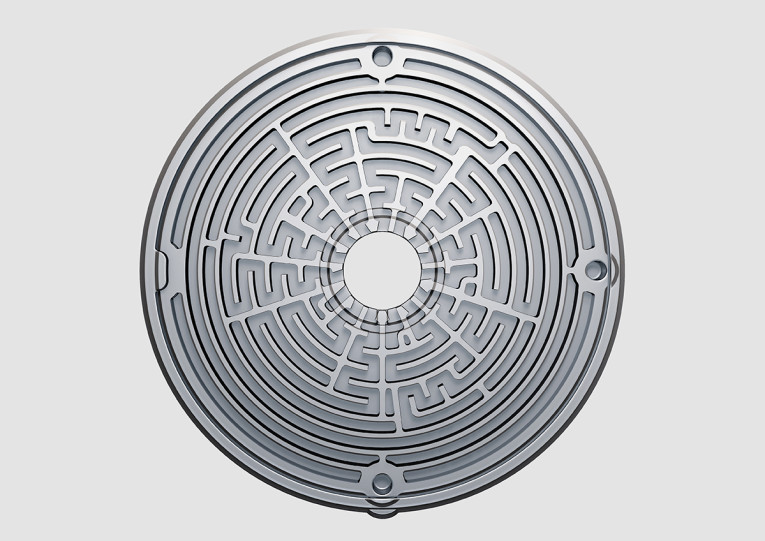
In the Studio
I wanted to provide a real-world comparison and, as I don’t own any speakers close in price or type, I hauled a pile of gear over to Kent Peterson’s commercial studio. 8VB Recording in Minneapolis, MN, counts two pro stand mounters among its inventory; Sennheiser’s Neumann KH 80 and the larger PreSonus Sceptre S8. Both are ported, powered two-way designs. Since the LS50 Metas are not powered, we wrestled the Edge W into place under the mixing console and ran my set of Anticables up to the Metas.
Though the sound of the Presonus speakers were new to me, I have some familiarity with the Neumann’s house sound, having done seemingly countless demos at an Audio Engineering Society (AES) convention using their compact KH 310 family. A bit after getting everything dialed in, Kent’s business partner, drummer Pete Quirsfeld, arrived to join us in our nitpicking endeavors. Pete sniffed around the Metas and proclaimed them handsome, my better half would not disagree.
In short order, we fired up Tidal’s browser playback mode and started listening to a range of styles during the evening, from De Staat and Outkast to Brad Mehldau and Joe Henderson. What struck us all was the similarity of voicing between the Neumanns and the KEFs. The KEFs had a touch more upper-mid presence, while the Neumanns had a tighter, more extended bottom, but their similar midrange honesty was notable. These are both examples of relatively uncolored truth, which we found surprising since one is a consumer product. That KEF voicing speaks to a philosophy I share with them, an audio “Hippocratic Oath.” It’s an aim to do no harm to your music, conveying the intent without warping the timbre, tarting it up, or adding layers of distortion for good or ill.
Following a good bit of listening to that pairing, we swapped out the Neumanns for the PreSonuses and were immediately struck by the difference in midrange and bass. The Sceptre S8 focuses on the midrange, with an in-your-face presentation that takes no prisoners. It’s sort of an NS-10 on steroids.
The larger cabinet volume of the Sceptre S8s made for a more extended low end, but their shouty character swamped any other aspect when trying to make a comparison. I also detected a throaty telltale with the PreSonus kids, their tweeter is horn-loaded, which was absent in the other two. After several hours of swapping seats and furrowed brows, we all agreed that we could easily live comfortably with the Metas.
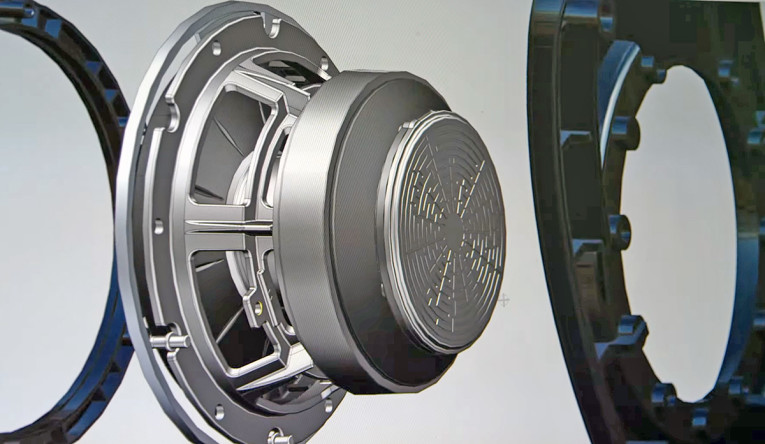
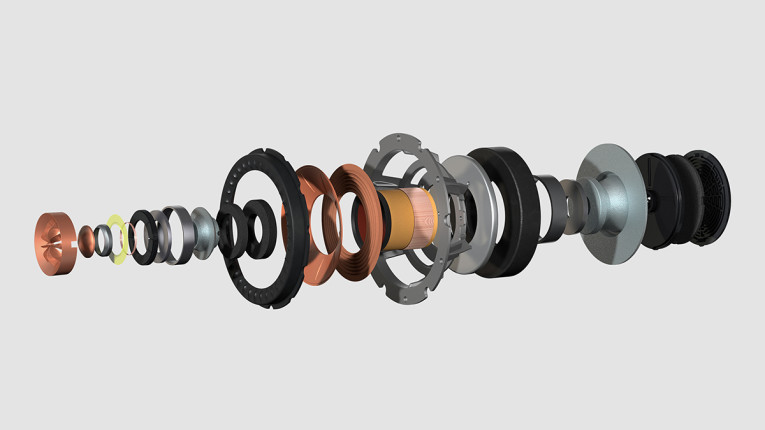
The Verdict
After all was said and done, there’s little I could find at fault with Oclee-Brown’s creation. Yes, they are “bookshelf” speakers but, being rear ported, would not be happy in a bookshelf. They also do not go terribly low, nothing that KEF’s Kube Series sub ($550 to $750) or the newly released KC62 subwoofer with Uni-Core technology ($1,499), can’t cure. Also, their high end is somewhat limited. They start to roll off slightly at about 15 kHz and so do not have gobs of “air.” Yet, within their usable range, they provide surprisingly flat, well-behaved frequency response and low distortion resulting in a winning, balanced character.
For some, this is an aspirational product and, for others, it’s a bargain. The LS50 Meta sits in that value sweet spot of nice price, exceptional performance without significant qualification, and a clean visual appeal for those who care about appearances as well as sound quality. Very few speakers that I know of targeted at consumers portray the neutrality and intent as well as the second-generation LS50 passive. Designer Oclee-Brown told me that, “We certainly try and get (the on-axis response) nice and tidy but we’re more focused on delivering an even sound into the room in all directions. Our CEA2034 (spinorama) acoustical testing data and resulting graphs have many different curves, all of which are smooth and monotonic. This is the key to a great sounding loudspeaker.”
Amen brother — great sounding, compact, and good looking. The LS50 Meta has a wonderful combination of attributes, all of which combine to reinforce my original impression. I l-o-v-e these speakers and, at $1500 a pair, they would serve any audiophile in good stead for many years. Very highly recommended. aX

LS50 Meta $1499.99/pair
www.kef.com
Author’s Note: *Gold Peak Group, the Hong Kong–based corporate parent of GP Acoustics (UK), is an Asian multinational whose holdings include KEF and Celestion.
This article was originally published in audioXpress, June 2021.
 About the Author
About the AuthorO. A. Masciarotte has spent more than 40 years immersed in the tech space, working on manufacturing, marketing, and product development for many pro and CE audio manufacturers including dbx, a/d/s, Lexicon, Sonic Solutions, and Minnetonka Audio. His client roster is as diverse as Apple, Harper Collins, NASA Johnson, NPR and Universal. His writings include a book covering file–based music for the home and more than 100 articles for sundry trade publications. A member of the Audio Engineering Society (AES), Society of Motion Picture and Television Engineers (SMPTE), Project Management Institute (PMI), and Digital Cinema Society (DCS), he is currently co-founder and CMO of MAAT Incorporated, a digital audio software manufacturer.
KEF LS50 Meta: The Measurements
After conducting a serious listening session of the KEF LS50 Meta with Oliver Masciarotte and Pete Quirsfeld, Kent Peterson took the speakers to Warkwyn to determine if their listening impressions could be confirmed with actual measurements. Read the article by Kent Peterson here.
What are Metamaterials?
Manmade structures called metamaterials have significantly upgraded our ability to steer waves and energy in electromagnetism, optics, acoustics, and mechanics. Our current understanding of acoustic metamaterials stems from previous work done in the realms of electromagnetism and photonics. Radar cloaking and superlensing, compact, man-made structures that operate on a scale much less than the relevant wavelength of a traditional lens, resulted from that research. Starting early in this century, the principles learned from those and prior efforts resulted in the creation of the first modern acoustic metamaterials. Optical and acoustical metamaterials share many similar approaches to implementation. By incorporating novel, carefully chosen subwavelength structures into macroscopic materials, acousticians can create devices with exotic soundaltering properties.
As Sebastien Degraeve and Jack Oclee-Brown state in their Audio Engineering Society (AES) Convention Paper 10341 “Metamaterial Absorber for Loudspeaker Enclosures”: “Acoustic metamaterial absorbers can realize previously unattainable absorption spectra with sub-wavelength dimensions approaching the theoretical minimum... To shrink the size of the rear absorber, one possible approach is to use resonant acoustical absorbers such as Helmholtz oscillators or quarter-wavelength ducts.
Acoustical resonators are extremely efficient sub-wavelength absorbers but they have the disadvantage of being narrowband in character. Adding damping increases the bandwidth but limits the absorption. An ideal solution would be to arrange a structure containing many high-Q resonators optimised to provide a wide bandwidth of overall absorption. In this context, acoustic metamaterials can deliver unconventional effective properties without the constraints normally imposed by nature.”
There it is in a nutshell, those last two sentences tell the tale. Cluster together a collection of sub-wavelength tuned structures, and their lumped behavior acts in a novel manner. In the past two decades, the steady advance of additive manufacturing techniques in concert with improvements in computational sciences has resulted in the fabrication of physical objects with elaborate topologies that defy Newtonian physics and the recognized canon of legendary acousticians with their nonintuitive behavior. Imagine that someday an advanced hobbyist will build a full-frequency acoustical pipe organ in the footprint of a coffee table.
As all speaker builders know, the bulk impedance of traditional absorption is inconsistent when applied, relatively large physically and a bit of a pain to work with. As Steve Cummer, professor of electrical and computer engineering at Duke University, states on YouTube, “The materials that are used (for sound-proofing or amplitude reduction) right now are (physically) pretty big and not easy to deploy, and absorb essentially all frequencies of sound, all pitches. With metamaterials, we have the ability to design much more compact, thinner structures that absorb only the frequencies, the pitches, that we want to absorb, leaving the rest of the sound... unaltered.”
In 2006, a Duke research team demo’d an optical cloaking device. Then, in 2014, Cummer and his band of merry experimenters announced the world’s first three-dimensional acoustic cloaking device, a perforated plastic metamaterial shell that can be placed over a small object to make it acoustically invisible. The Romulans would be proud.
